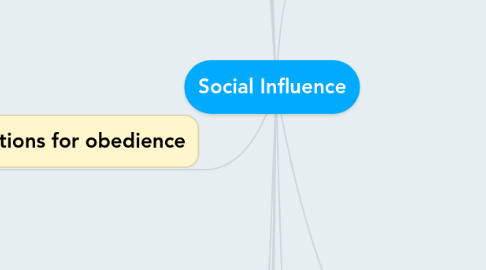
1. Asch's line study
1.1. PROCEDURE: 5-7 participants/group - Each group was presented with a standard line & 3 comparison lines - only one true participant, rest were confederates- confederates gave wrong answer on 12/18 trials
1.2. RESULTS : Participants conformed on 32% of trials where confederates gave the wrong answer- 75% of the sample conformed to the majority at least once
1.3. EVALUATION: -lacked ecological validity; based on perception of lines so doesn't reflect complexity of real life conformity -sampling issues; only carried out on men, gender bias, results can't be generalized to females so lacks population validity -Ethical issues: deception;participants were told the study was about perception of lines, no informed consent, potentially caused embarrassment, although they were debriefed
2. Variables affecting conformity
2.1. Group Size: An individual is more likely to conform when in a larger group -Asch found conformity didn't increase after group size was 4/5
2.2. Task Difficulty: We look to others for conformation so when the difficulty of task is greater the conformity increases e.g. When Asch made the lines more similar conformity increased
2.3. Unanimity: A person's more likely to conform when all members of the group are in agreement and give the same answer. - when a person in the group gave a different answer conformity dropped as group answer wasn't unanimous
3. Milgram's study on obedience
3.1. AIM: wanted to see whether people would obey a legitimate authority figure when given instructions to harm another person
3.2. PROCEDURE: created a set up where 2 participants were assigned either role of teacher/learner -learner was always a confederate . They were put in separate rooms, the experimenter asked the teacher to administer electric shocks to the learner every time he was incorrect (had to learn word pairs) had to increase voltage every time. 15-450 volts. Experimenter gave prods when participants refused to continue
3.3. RESULTS: all participants went to 300 volts, 65% were willing to go to 450 volts- carried out 18 variations e.g. when experimenter prompted from another room obedience fell to 20.5%
3.4. EVALUATION: Lacked ecological validity; carried out in a lab under artificial conditions, not possible to generalise to real life gender biased -only males, cant generalise to females Gives insight & highlights how we can all be blind to obedience used a standardised procedure so it improves reliability and helps establish a casual relationship Ethical issues: Deception: participants believed they were actually shocking a person-milgram argued that illusion is necessary & 83.7% said they were glad to be involved Protection of Participants- exposed to stressful situations could've potentially cause psychological harm- many were visibly distressed- 3 participants had seizures Milgram argued that these effects were only short term- participants interviewed after 1 year, most said they were glad that they took part
4. Explanations for obedience
4.1. The Agentic State Agency theory says that people will obey an authority when they believe that the authority will take responsibility for the consequences of their actions. Supported by some aspects of Milgram's evidence
4.2. Legitimacy of Authority Figure People tend to obey others if they recognise their authority as morally right/ legally based
4.3. Situational Factors
4.3.1. Uniform-Milgram's experimenter wore a lab coat which gave him a high status, when experimenter dressed in everyday clothes obedience was very low
4.3.2. Status of Location- Milgram's experiment was conducted at Yale, a prestigious uni. The high status of the uni gave the study credibility & respect in the eyes of the participants making it more likely that they obey. When the experiment was moved to a set of run down offices obedience dropped to 47.5%
4.3.3. Proximity of Authority Figure- people are more likely to obey an authority figure who's nearby, if they're distant it's easier to resist their orders. When the experimenter instructed & prompted the teacher by telephone obedience fell to 20.5%
4.4. Dispositional Explanation: Authoritarian Personality - Adorno felt that personality factors rather than situational factors could explain obedience. He proposed that there was such a thing as authoritarian personality; they're more likely to obey, hostile to those of inferior status .
5. Explanation of Resistance to Social Influence
5.1. Social Support- In one of Asch's variations he showed that the presence of a dissident led to decrease in the conformity levels in true participants, made them feel more confident in own decision & more confident in rejecting the majority position
5.2. Locus of Control- refers to how much control a person feels they have in their own behaviour, can have internal/external. People with high internal locus of control perceive themselves as having a great deal of personal control over their behaviour & are therefore more likely to take responsibility for the way they behave. A person with high external locus of control perceive their behaviour as being a result of external influences or luck -usually more obedient.
6. Minority Influence- occurs when a small group influences the opinion of a much larger group
6.1. Consistency- Moscovici stated that being consistent & unchanging in a view is more likely to influence the majority, 2 types: Diachronic consistency- over time, doesn't modify views & Synchronic consistency- all members agree and back each other up - important because members of the majority will rethink their position and consistent minority disrupts established norms and creates uncertainty, doubt & conflict. Can lead to majority taking minority view seriously
6.1.1. Moscovici conducted an experiment where 36 blue slides of different intensity were shown to female participants and asked to report the colours. There were 2 confederates and 4 participants. In the first part of the experiment the 2 confederates answered green for each slide. In the second part they answered green 24 times and blue 12 times. When confederates were consistent in their answers 8% of participants said the slides were green. When they were inconsistent only 1% said green.
